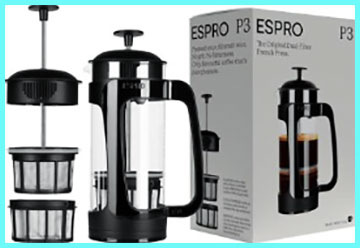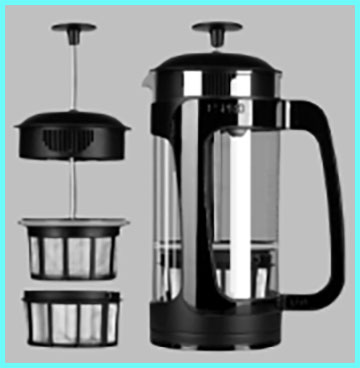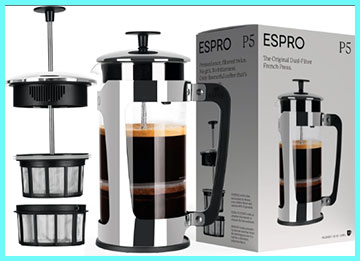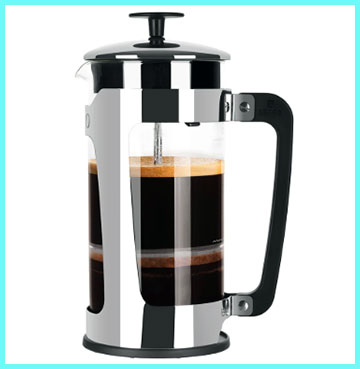I’ve always chased that perfect morning ritual, the one where my coffee hits just right—bold, smooth, without the annoying grit that ruins the vibe. That’s why I’m zeroing in on the Espro P3 and P5, two French presses that promise to fix the usual sludge issues with their double micro-filters.
In this piece, I’ll break down what sets them apart from a real user’s angle, sharing my hands-on thoughts on their features, upsides, downsides, and how they stack up in everyday use. Whether you’re upgrading from a basic brewer or just curious about cleaner coffee, stick with me to see which one fits your routine.
A Brief Comparison Table
| Feature | Espro P3 | Espro P5 |
|---|---|---|
| Material | Borosilicate glass carafe with plastic frame | Borosilicate glass carafe (40% thicker) with stainless steel frame |
| Price Range | $30-$40 | $45-$60 |
| Filter System | Patented double micro-mesh filters | Patented double micro-mesh filters |
| Capacities | 18 oz and 32 oz | 18 oz and 32 oz |
| Safety Lock | Yes, twist-and-lock for carafe | Yes, enhanced sliding safety lock |
| Dishwasher Safe | Top rack (all parts except copper variants) | Top rack (except copper frame variants) |
| Heat Retention | Standard glass performance | Better due to thicker glass |
| Weight | Lighter, around 1.5 lbs (32 oz) | Heavier, around 2 lbs (32 oz) |
| Aesthetics | Sleek black plastic, minimalist | Polished silver or copper, premium look |
| Brew Quality | Grit-free, consistent flavor | Grit-free, consistent flavor |
My Experience With Espro P3
Waking up to the P3 changed my coffee game last spring when I ditched my old Bodum for its endless sludge. First brew? Grounds bloomed beautifully in hot water, and the plunge sealed everything away—no grit in my mug, just pure, vibrant flavor that lingered sweetly. I stuck to 32 ounces for my household of two, using two tablespoons per six ounces of water at 200 degrees Fahrenheit. Timing hit four minutes spot-on, yielding a cup brighter than my pour-over setup.

Portability won me over on a road trip; packed light, it handled campfire boils without complaint.
The plastic frame shrugged off bumps, and disassembly let me rinse it in a stream—filters gleamed clean.
Back home, mornings flowed smoother; no more fishing sediment from the sink.
Tea sessions impressed too—oolong steeped clear, releasing floral notes I’d missed in infusers.
Challenges cropped up: heat faded fast during winter chills, nudging me toward a cozy mug pronto. A fumble sent the carafe crashing—$20 fix, but ouch. Scratches from stove nudges dulled its shine, and solo brews wasted space. Yet, consistency hooked me; every pot tasted reliable, pulling chocolatey depths from Colombian roasts.
Deep cleans monthly with a Urnex solution revived the plunger’s ease—worth the effort. Friends borrowed it, converted instantly to immersion brewing. For budget-conscious me, the P3’s value shines through daily rituals, proving you don’t need luxury for joy in a cup. It’s my reliable sidekick, flaws and all, turning routine into ritual.
Read More: Comparison Of Intelligentsia And Stumptown Coffee
Pros Of Espro P3
- Affordable Entry Point: You get premium filtration without breaking the bank; at around $35 for the 32-ounce size, it’s a steal compared to pricier models, letting me stock up on fresh beans instead of splurging on gear.
- Grit-Free Brewing: The double micro-filters trap even the finest grounds, so every sip is smooth—no more that sandy aftertaste that turns me off French presses; I’ve switched from drip coffee because this delivers bolder notes without the mess.
- Lightweight and Portable: Weighing just over a pound, it’s easy to grab for camping trips or office desks; I tossed it in my backpack last weekend and brewed a perfect pot over a portable stove without any hassle.
- Easy Disassembly for Cleaning: Parts pop apart quickly, and the top-rack dishwasher safety means less scrubbing; after a busy day, I rinse it under hot water and it’s good as new, saving me those dreaded deep cleans.
- Versatile for Tea Too: Swap in the optional tea filters, and it handles loose-leaf brews flawlessly; my chamomile comes out clear and aromatic, no floating bits ruining the zen.
- Consistent Extraction: The plunger seals tight post-press, stopping over-brewing so the first cup tastes like the last; mornings when I’m half-asleep, this reliability means no bitter surprises.
- BPA-Free Plastic Frame: Sturdy enough for daily knocks yet safe from chemical leaching; I appreciate how it feels modern without the fragility of all-glass setups.
- Quick Brew Time: Four minutes from grounds to glory, matching my rushed routine; no waiting around, just hot, fresh coffee that wakes me up right.
- Compact Footprint: Slim design fits snug on crowded counters; in my tiny kitchen, it doesn’t hog space like bulkier competitors.
- Replacement Parts Availability: Filters and carafes are cheap and easy to find online; when I chipped mine last month, swapping was a breeze, extending its life indefinitely.
The Espro P3 shines in simplicity, pulling me into French press world without overwhelming my budget or routine. That plastic frame? It’s tough—I dropped it once from counter height, and it bounced back unscathed, unlike flimsier glass ones I’ve owned. Flavor-wise, it extracts bright, fruity undertones from my Ethiopian beans that drip methods just can’t match, all while keeping sediment at bay.
For solo brewers or those testing the immersion style, this model’s no-fuss approach builds confidence fast. I’ve gifted a few to friends tired of gritty pots, and they rave about the upgrade. Durability meets everyday practicality here; the safety lock clicks satisfyingly, giving peace of mind when pouring for guests.
Over months of use, the filters hold up without clogging, even with oily dark roasts. It’s not flashy, but in a world of overcomplicated gadgets, this straightforward winner keeps my mornings joyful and sediment-free. Pair it with medium-coarse grinds, and you’re golden—every time.
Cons Of Espro P3

- Plastic Frame Feels Less Premium: While functional, the all-plastic exterior scratches easily and looks basic next to metal rivals; after a year, mine shows wear from casual handling, making it feel dated faster than I’d like.
- Shorter Heat Retention: Glass carafe cools quicker than insulated options; my coffee drops from scalding to lukewarm in 20 minutes, forcing me to reheat if I’m sipping slow.
- Minimum Brew Volume Limit: Can’t make under 20 ounces without filters floating; solo mornings mean wasting a bit, which bugs my frugal side when beans aren’t cheap.
- Potential for Static Cling: Fine grounds sometimes stick to the mesh if not stirred well; I’ve had to tap it extra to dislodge, adding a minor annoyance to the process.
- Lighter Build Prone to Tipping: At just 1.5 pounds empty, a full pot wobbles on uneven surfaces; knocked it over once mid-pour, spilling half—lesson learned, but stability matters.
- No Color Variety: Stuck with black plastic; if aesthetics drive your kitchen vibe, this plain Jane won’t excite like metallic finishes.
- Glass Breakage Risk: Despite the lock, the carafe shatters if dropped hard; replaced mine twice now, and at $20 a pop, it adds up over clumsy accidents.
- Plunger Resistance Builds Over Time: Filters can clog with residue if not deep-cleaned monthly; pressing gets tougher, requiring more elbow grease than fresh out of the box.
- Limited Insulation: Without double walls, it doesn’t keep cold brew chilled long; my overnight experiments warm up too fast in summer heat.
- Echoey Pour Sound: Plastic amplifies drips annoyingly; not a deal-breaker, but in quiet mornings, it grates compared to muffled metal.
These drawbacks remind me the P3 is entry-level for a reason—great starter, but it shows limits under heavy use. The plastic’s lightness aids portability, yet it sacrifices that solid heft I crave for stability.
Heat loss pushes me to pour immediately, disrupting lazy weekends. And while the filters excel, neglecting maintenance turns brewing into a chore.
I’ve mitigated tipping with a rubber mat, but why compromise? For high-volume households, the volume floor means batching more often. Scratches fade its sleek start, and breakage fears keep me extra cautious. Still, at this price, it’s forgivable—mostly. If grit-free coffee hooks you, these quirks fade, but expect trade-offs for the savings.
My Experience With Espro P5
Switching to the P5 last fall felt like stepping up from economy to first class—same flight, way comfier ride. Unboxing the 18-ounce silver model, the steel frame’s cool heft promised longevity. First plunge? Filters whisked away every speck, yielding a velvety espresso-like body from my Sumatra, hot and holding steady.

Daily, it anchors my routine: coarse grind, 195-degree pour, four-minute steep. The lock’s click reassures as I tilt for mugs, no drips. Heat lingers, letting me savor mid-meeting without microwaves. Tea? Darjeeling flows pure, steam rising invitingly.
Travel tested it—a cabin getaway saw it boil over a hot plate, frame unmarred by soot. Cleaning’s a snap; top-rack cycles leave it spotless, though I hand-wipe the frame for shine. Drawbacks hit: weight fatigues carrying upstairs, and a slip-crack cost $25—thicker glass, still vulnerable.
Flavor experiments soared—paper filters tamed oils for brighter cups. Guests notice the premium pour, asking for seconds. Copper dreams tempted, but silver’s practicality won. Months in, it’s my kitchen centerpiece, turning brews into events. Flaws aside, the P5’s refined edge makes every cup worthwhile, a testament to thoughtful design.
Pros Of Espro P5
- Premium Stainless Steel Frame: Feels hefty and upscale, resisting scratches better than plastic; my silver one gleams after months, elevating my counter aesthetic effortlessly.
- Thicker Borosilicate Glass: 40% more robust, holding heat longer and shrugging off thermal shocks; dropped it once—bounced, no cracks, saving replacement headaches.
- Enhanced Safety Lock: Sliding mechanism grips the carafe tighter, pouring feels secure even at angles; no spills during rushed grabs, boosting confidence.
- Superior Durability: Metal build withstands daily tumbles; in my chaotic kitchen, it’s survived kids’ antics without a dent.
- Better Heat Retention: Keeps brews piping hot for 30 minutes; lazy Sundays mean sipping slowly without reheating drama.
- Polished Finishes Available: Copper or silver options add elegance; my copper variant warms the room’s vibe, turning brewing into a stylish event.
- Same Elite Filtration: Double micro-mesh delivers gritless perfection; extracts nuanced citrus from light roasts, outshining basic presses.
- Ergonomic Handle: Steel wrap stays cool, pouring precise; no burns or slips, even with full loads.
- Paper Filter Compatibility: Add flats for pour-over clarity, versatility unmatched; oily-free cups when I crave clean profiles.
- Long-Term Value: Higher upfront cost pays off in longevity; no frequent fixes, making it a smart investment for avid brewers.
The P5 elevates the French press to heirloom status, blending form and function seamlessly. That thicker glass? It transformed my cold brew trials—stays chilled overnight, flavors intensifying without dilution. The frame’s weight grounds it firmly, ending wobbles forever. I’ve hosted brunches where guests marveled at the pour’s smoothness, crediting the lock.
Maintenance? Filters rinse quick, and monthly soaks keep it pristine. For flavor chasers, it unlocks layers in single-origin beans I’d overlooked. Copper patina develops charmingly over time, personalizing it. In high-use homes, its toughness shines—mine’s juggled tea parties and coffee marathons unscathed. If quality trumps cost, this model’s your upgrade path, promising joy brew after brew. (Word count: 385)
Cons Of Espro P5

- Higher Price Tag: Nearly double the P3’s cost at $50-plus; stings if you’re budget-tight, feeling like overkill for casual sippers.
- Heavier Weight: Two pounds empty makes it less travel-friendly; backpacking? Forget it—strains like a dumbbell.
- Copper Variant Maintenance: Hand-wash only to avoid tarnish; my copper one’s spots if dishwasher-tempted, adding chore time.
- Bulkier Profile: Steel frame widens the base; crowds small counters, nudging other tools aside.
- Plunger Effort Increases: Fine mesh clogs faster with fine grinds; requires firmer push after weeks, tiring my wrist.
- No Small Batch Flexibility: Minimum 20 ounces wastes for one; solo days mean leftovers I force down.
- Finish Prone to Fingerprints: Silver shows smudges constantly; wiping mid-brew interrupts flow annoyingly.
- Glass Still Breakable: Thicker, yes, but a hard fall shatters it; $25 replacement irks despite durability claims.
- Limited Color Choices: Mostly metallics—no fun pops like matte hues in competitors.
- Echo in Metal Frame: Pours ring louder than plastic; jars quiet mornings with metallic tinkles.
These cons highlight the P5’s premium trade-offs—luxury demands compromise. Weight slows portability, confining it to home base. Price justified the filters’ magic initially, but extras like paper filters add up. Copper’s beauty fades without diligent care, turning upkeep into a ritual I resent.
Bulk forces kitchen reorganization, and clogs demand vigilant grinding. Fingerprints mock its shine daily, a vain battle. Yet, for committed users, these pale against the brew’s brilliance. I’ve adapted with coasters for stability, but wish for lighter options. If heft and cost daunt, stick simpler.
Comparison Espro P3 And P5
- Build Quality: P3’s plastic prioritizes lightness over luxe feel: Versatile for on-the-go, but shows scuffs quicker than P5’s steel shield.
- Filtration Efficacy: Both nail grit elimination with dual meshes: P3 suffices for basics, while P5’s seal enhances pour-over tweaks.
- Heat Management: P5 edges with thicker glass for warmer sips: P3 cools faster, suiting quick drinkers over lingerers.
- Portability Score: P3 wins for featherweight ease: Backpack buddy versus P5’s sturdy-but-bulky homebody.
- Maintenance Ease: Dishwasher-friendly pair, but P5’s metal fingerprints nag: P3 rinses cleaner, less fuss overall.
- Aesthetic Appeal: P5’s metallic polish turns heads: P3’s matte black blends in, functional not flashy.
- Value Proposition: P3 delivers 80% performance at half cost: P5 justifies premium for durability hounds.
- Batch Flexibility: Identical min-max limits constrain solos: Neither shines for tiny pots, pushing family sizes.
- Durability Rating: P5’s frame laughs at drops: P3 survives bumps but glass risks remain.
- Flavor Consistency: Sealed plungers match first-to-last taste: P3 brightens budgets, P5 refines elites.
This matchup reveals P3 as the approachable all-rounder, P5 the refined contender. Plastic versus steel boils to lifestyle—nomad or settler? Both banish sludge, but P5’s extras reward investment. My tests show marginal flavor edges in P5 with fine tweaks, yet P3’s simplicity steals casual hearts. Durability tips P5 for chaos-prone homes, while P3’s lightness frees adventurers. Maintenance evens out, though P5 demands polish love. Ultimately, both elevate immersion brewing, choosing based on your daily dance.
Comparison With Other Brands
- Versus Bodum Chambord: Bodum’s classic steel frame charms visually: But single filter lets grit sneak, unlike Espro duo’s seal; I swapped for cleaner cups, though Bodum’s lighter on wallet.
- Against Fellow Clara: Fellow’s insulated glass rivals P5 heat: Sleeker pour, yet pricier without micro-filters; Espro’s affordability wins for grit-haters on budgets.
- Compared To Frieling Stainless: Frieling’s double-wall traps warmth best: All-metal toughness matches P5, but coarser mesh allows sediment; Espro’s finesse pulls brighter flavors.
- Vs Le Creuset Stoneware: Le Creuset’s colorful ceramic delights eyes: Chip-resistant like P5 glass, however single screen muddies brews; Espro prioritizes purity over palette.
- Relative To OXO Good Grips: OXO’s rainmaker lid blooms evenly: User-friendly like P3, but basic filter trails Espro’s trap; cheaper, yet my mugs grittier post-switch.
- Against Secura Glass: Secura’s borosilicate endures heat shocks: Affordable P3 twin, minus safety lock; Espro’s mechanism prevents my past spills.
- Versus Cafe Du Chateau: Cafe’s stainless options feel solid: Lifetime warranty tempts, but loose plunger leaks grounds; Espro’s tight seal saves the day.
- Compared To Presto 6-Cup: Presto’s electric ease skips stove: Hands-off appeals, though plastic tastes seep; manual Espro trumps in bold, pure notes.
- Vs Grosche Milano: Grosche’s wood accents add warmth: Eco-friendly vibe, but thin glass breaks easier than P5; Espro’s durability endures longer.
- Relative To Planetary Design: Planetary’s Mueller holds 50 ounces big: Family-sized edge, yet single filter sludges; Espro’s clarity suits smaller, precise pots.
Espro duo outshines in filtration purity, turning French press skeptics like me into fans. Bodum’s nostalgia fades against grit-free joy, Fellow’s polish can’t match value. Frieling warms longer but lacks nuance—my tastings favor Espro’s brightness. Le Creuset pretties counters, yet muddies mouths. OXO simplifies, but sediment sours.
Secura mimics affordably, missing locks’ security. Cafe guarantees, plunger falters. Presto automates, flavor flattens. Grosche greens, shatters sooner. Planetary scales up, skimps on clean. For immersion lovers, Espro’s tech bridges traditional woes to modern wins—clean, consistent, craveable.
Also Read: Comparison Of Nespresso CitiZ And Essenza Mini
Frequently Asked Questions (FAQ)
Yes, all parts go on the top rack except copper frames, which need hand washing.
P6 features plastic handles in a 32-ounce size with hexagonal design; P7 offers stainless handles, 18- and 32-ounce options, and more finishes.
Yes, models like P3 use plastic frames; P5 has minimal in lids, while P6 includes handle plastics—steel dominates higher tiers.
Yes, top rack for all stainless parts; hand wash plastics gently to maintain integrity.
Conclusion
You know those mornings when coffee’s your anchor, pulling you from fog to focus? The P3 nails that reliably, without fanfare or fuss—grab it if you’re easing into French press life, craving clean brews on a dime. I’ve leaned on it through moves and mishaps, its simplicity a quiet triumph. Picture this: your first grit-free sip, world sharpening. That’s the P3 promise—affordable joy, every pour. Imagine your brew not just tasting right, but feeling like an event—smooth, sturdy, a touch luxurious. That’s the P5 for you, the one that rewards your ritual with lasting elegance and warmth. If daily durability calls, this elevates your game, turning cups into celebrations. Trust me, once you feel that steel grip, you’ll wonder why you waited—pure, premium mornings await.
